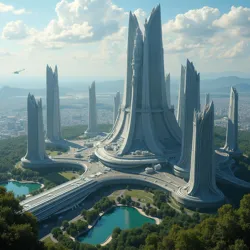United States Technocratic Republics (2761 CE)
 The administrative capital of New Washington, showing its distinctive bioengineered crystal spires and atmospheric purification arrays
The administrative capital of New Washington, showing its distinctive bioengineered crystal spires and atmospheric purification arraysThe United States Technocratic Republics (USTR) is the current governmental structure of the former United States of America in the year 2761 CE. Following the Great Reorganization of 2651, the nation transformed from a traditional democratic republic into a system of merit-based governance driven by scientific and technological expertise. The country now spans most of North America, including the former territories of Canada and Mexico, which joined during the Continental Unification Process of the late 27th century.
Current State
The USTR operates under the principles of the Third Constitutional Framework, which replaced the original U.S. Constitution in 2652. The nation is divided into 12 specialized administrative regions, each focused on specific technological or societal domains, rather than traditional geographic boundaries. The population of approximately 750 million citizens lives primarily in massive arcologies and sustainable megalopolises, with vast stretches of rewilded territories between urban centers.
Government Structure
The traditional three branches of government have evolved into the five Pillars of Governance: the Technical Assembly, the Ethical Oversight Council, the Resource Distribution Network, the Innovation Directorate, and the Social Harmony Commission. Leadership positions within each Pillar are earned through a combination of demonstrated expertise, practical achievement, and successful completion of rigorous certification processes.
The current First Administrator, Dr. Sarah Chen-Martinez, oversees the coordination between the five Pillars from the New Washington Complex, having earned the position through her groundbreaking work in biomechanical social systems and successful management of the Western Arcology Network.
Society and Culture
Modern American society in 2761 bears little resemblance to its historical counterpart. The integration of neural enhancement technology and collective consciousness frameworks has fundamentally altered how citizens interact and participate in governance. The average lifespan has extended to 180 years, thanks to advances in cellular regeneration and environmental optimization.
 Citizens engaging in a public forum through neural interface technology in New Boston's Central Plaza
Citizens engaging in a public forum through neural interface technology in New Boston's Central PlazaEducation occurs through a combination of direct neural downloads and practical experience in specialized Learning Pods. The traditional concept of work has been largely replaced by voluntary contribution to society, as automation and artificial biological systems handle most essential production tasks. Citizens instead focus on creative pursuits, scientific research, and social development.
Technology and Infrastructure
The USTR's infrastructure is maintained by a network of self-repairing smart materials and biological computers. Transportation occurs primarily through gravity manipulation corridors and molecular teleportation networks, though personal flying vehicles remain popular for recreational use.
The nation's energy needs are met entirely through a combination of fusion arrays, orbital solar collectors, and deep-Earth thermal tapping. The atmosphere is actively managed by a network of weather control towers and carbon processing facilities, which have successfully reversed the climate changes of previous centuries.
Defense and Security
National security is maintained through a combination of automated defense systems and the Citizen Protection Network. Traditional military forces have been replaced by specialized response units that handle everything from natural disasters to potential conflicts with off-world colonies. The USTR maintains peaceful relations with other Earth nations through the Global Cooperation Initiative, though tensions occasionally arise with the Lunar Independence Movement.
Environmental Management
One of the USTR's greatest achievements has been the successful restoration of North American ecosystems. Through the use of genetic restoration technology and environmental engineering, many extinct species have been brought back and vast wilderness areas have been re-established. The Great Plains Restoration Project stands as a prime example, where genetically enhanced bison herds once again roam freely alongside reconstructed passenger pigeons and other revived species.
Current Challenges
Despite its technological advancement, the USTR faces several ongoing challenges. The Digital Consciousness Rights Movement continues to advocate for the full recognition of artificial intelligences as citizens. Debates rage within the Technical Assembly regarding the ethical implications of time dilation technology and its potential effects on society. Additionally, the recent discovery of alternative dimension access points has raised questions about inter-dimensional governance and security.
International Relations
The USTR maintains complex relationships with other global powers, including the Pan-Asian Cooperative, the European Union of Enhanced States, and the African Technology Federation. While Earth remains largely peaceful, competition for resources in space has led to the establishment of the Solar System Treaty Organization, which works to prevent conflicts over extraterrestrial mining and colonization rights.
Future Prospects
As the USTR approaches its 785th year, it continues to evolve. Current initiatives include the development of consciousness transfer technology, the expansion of orbital habitats, and the controversial Human Evolution Initiative. The nation's leadership remains committed to technological progress while working to address the social and ethical challenges that arise from such advancement.
The Third Century Forward Plan, currently under development by the Technical Assembly, outlines ambitious goals for the next hundred years, including the establishment of self-sustaining colonies on Mars, the complete elimination of disease through advanced biotechnology, and the potential implementation of temporal stabilization fields to protect against theoretical time-travel paradoxes.